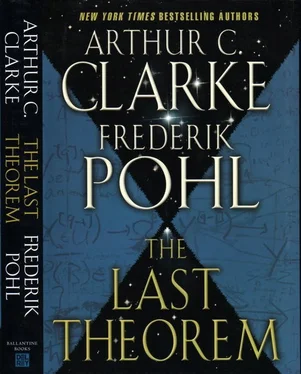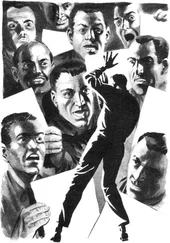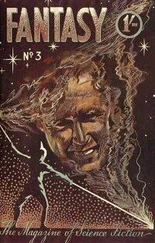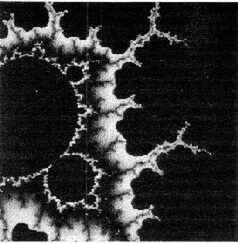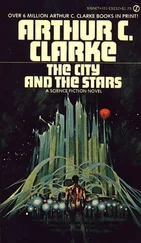Mother tells me that you have some vacation time coming. I’ll be down at the terminal for at least a week, starting the first of next month. Why don’t you come see what we’re doing these days?
“Actually,” Myra said, “that would be fun.” And Natasha said, “You bet!” And even Robert, hanging on to Natasha’s chair and listening to every word, bellowed something that Natasha explained was a yes. And so the family of four prepared for its first long trip together.
It wasn’t just Vorhulst’s invitation that made Ranjit look forward to visiting the Skyhook terminal. There were actually two reasons, and the first was the advisory board that Vorhulst had talked him into joining a number of years ago. It had been as undemanding as Vorhulst had promised—no meetings to go to, not even any voting on any issues, because if there were any issues troublesome enough to require a decision, that decision was made for them by the real controllers of the enterprise, the governments of China, Russia, and the United States. Ranjit had, however, been the recipient of a monthly progress report. There too the heavy hand of the big three was felt, because most of each report’s content was sternly secret, and even more of it was simply dismissed as what was cryptically called “development.” He had only been to the site a handful of times, and those visits had been quite cursory. Whether he would learn more by being at the scene Ranjit could not say, but he was anxious to find out.
The other reason was a surprise to Ranjit himself. The Subramanians didn’t have a car of their own—Ranjit and Myra biked to most places, sometimes with Natasha riding happily in front of them and Robert strapped into a child’s seat behind his father, and when they needed more in the way of transport, there were always cabs. But the university had promised the loan of a car for the trip, and Ranjit picked it up from the grinning Dr. Davoodbhoy. “It’s special for you,” he said. “Pax per Fidem sent it. It’s a new design from transparent Korea—with all those geniuses who used to build weapons now free for new civilian ideas, they’ve got a lot of stuff.” And when he’d explained what the perky little four-seater could do, it sent Ranjit back to Myra grinning with pleasure.
“Get me a pitcher of water,” he commanded as he pulled up at their house. Mystified, she obeyed. She was even more mystified when he ceremoniously opened the fuel tank and poured the water in, and when he then started the motor and listened pleasurably to its purr, she was totally baffled.
He gave her the explanation Davoodbhoy had given him. “Boron,” he said. “It’s called the Abu-Hamed drive, after I don’t know who, maybe the person who invented it. You know the element boron is so hungry for oxygen that it’ll pull it right out of compounds like water? And when you take the oxygen out of the water molecule, what do you have left?”
Myra frowned at him. “Hydrogen, but—”
Grinning, he touched a finger to her lips. “But boron’s terribly expensive, and burning a carbon fuel’s so much cheaper that nobody ever bothered with it. But here it is! They’ve found out how to regenerate the boron so they can use it over and over. And so we’re driving a car that not only is low-emission, it doesn’t emit anything at all!”
“But—” Myra began again. This time he stopped his wife’s lips with his own.
“Get Natasha and Robert, will you?” he coaxed. “And our baggage? And let’s see how this hydrogen burner works.”
Which turned out to be very well. They did have to stop twice to add water to the fuel tank, under the scandalized stares of the people running the filling stations they stopped at, but the little car performed as well as any fossil-fuel burner.
They were still ten kilometers from the terminal when Robert emitted one of his heart-stopping shrieks. Myra jammed on the brakes, but it wasn’t a sudden danger. It was simply an exciting sight. What Robert was waving at (as he said “Spider!” and “Climb fast!” and “Many, many, many!”) was the cable of the Skyhook itself, barely visible as something that glinted from the sun. But what it carried, once you knew what to look for, was visible enough. There were the cargo-carrying pods, one after another, marching up into the sky and disappearing into the first layer of clouds.
“Huh,” Ranjit said. “Looks like they’ve really got it going, doesn’t it?”
So they had.
The road to the terminal was paired up with a railroad track, and as they were approaching, a train—forty-two freight cars, Natasha counted excitedly—overtook them and disappeared into one of the terminal’s giant sheds. There were guards at the car entrance, but they passed the Subramanian family with a friendly salute, and a wave in the direction of the VIP parking lot.
Where they were met by a handsome Asian woman who introduced herself as Joris Vorhulst’s assistant. “Engineer Vorhulst was looking forward to seeing you very much,” she informed them, “but he didn’t expect you until tomorrow. He’s on his way, though. Would you like something to eat?”
Ranjit opened his mouth to say what a good idea that was, but was overruled by his wife’s faster response. “Not just yet. If we could just look around for a bit—”
They could. They were warned to stay out of the loading sheds and, of course, to beware of the trucks and tractors that were lugging around unidentifiable bits and pieces of no doubt excitingly interesting objects.
Ranjit contemplated all the activity with benign incomprehension. “I’d give a lot to know what some of these things are,” he informed his family in general.
Young Natasha pursed her lips. “Well,” she said, “that lumpy package there is the thruster for an ion rocket. I think the bale next to it is carbon nanotubes in sheet form—I’d say probably part of a solar sail—”
Ranjit gazed at his daughter, openmouthed. “What makes you so sure?” he demanded.
She grinned at him. “While you were talking to that lady, Robert and I poked around, and I read the bills of lading. I think they’re building spaceships up there!”
“And,” called a familiar voice from the unloading shed, “you’re exactly right, Tashy! We’ve got a couple of them working already.”
Joris Vorhulst wouldn’t listen to any objections; he wanted food, decent Sri Lankan food, and if they didn’t want to eat, they could just watch him doing so. Because, it turned out, he had been five weeks on the Skyhook himself, and was just now coming back from supervising the work of those very spacecraft whose existence Natasha had deduced.
“Skyhook is really beginning to pull its weight,” he informed them happily. The two robot rocket ships that were already commissioned were working as scavengers, dedicated to combing LEO for abandoned spacecraft or even abandoned fuel tanks of ancient Russian and American ones. Once found, computer-controlled solar sails were mounted on them and they were programmed to sail themselves to Grand Central. There they were transformed. They were no longer dangerous free-flying spaceship killers. Now they were simply the raw materials for anything that needed to be built. “It’s all very well to ship stuff up from the surface,” Vorhulst declared, mouth full of what even Myra had to admit was a really good curry, “but why should we waste what’s up there already?”
“And that’s what you were doing up in LEO? Collecting scrap to build new things?”
Vorhulst looked embarrassed. “Actually,” he said, “I was making sure the third ship was ready to go. That’s the one that’s headed for the moon. You know that the robot explorers have been busy there for a few years now? And they’ve found plenty of those lava tubes I used to talk about in my astronomy class?”
Читать дальше
Конец ознакомительного отрывка
Купить книгу
